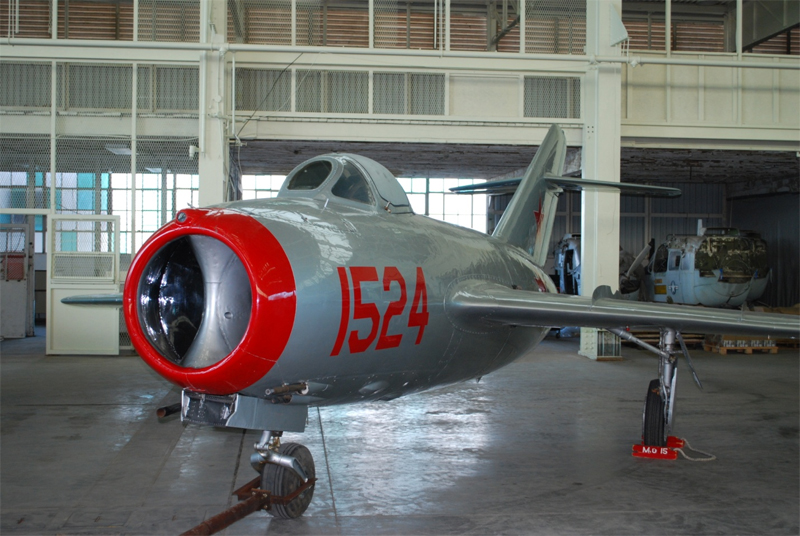Mikoyan-Gurevich MiG-15bis
May 2, 2013Posted on May 02, 2013
By Ray Panko | [email protected] | Pearl Harbor Aviation Museum
In November 1950, a fleet of small but very fast MiG-15s began to devastate United Nations fighters and bombers over North Korea. These new swept wing fighters were much faster and more maneuverable than U.S. Air Force fighters being used in the Pacific Theater at the time.
Only when the U.S. rushed F-86 Sabres into the fight several months later did the U.S.-led U.N. operation have a comparable fighter. Even then, there were far more MiGs than F-86 Sabres. Fortunately, these fighters remained in a small area in the north of North Korea called “MiG Alley.” MiG-15s denied U.N. forces air superiority until the U.S. learned to take advantage of the North American F-86s capabilities. Even the mighty B-29s were reduced to night bombing.

Figure 1: MiG-15 at Pearl Harbor Aviation Museum.
Most of these new MiG-15s were the improved MiG-15bis model. In World War II, the Soviets produced some of the best aircraft in the world, and they moved quickly into jets. They grasped the importance of German aerodynamic research and focused quickly on swept-wing aircraft. When the British inexplicably gave the Soviets copies of the Nene jet engine, which arguably was the best jet engine in the world at the time, the Soviets had the ability to create dominant fighters. Following traditional Soviet practices, the new MiG-15 was a light and simple fighter with no frills. Although the MiG-15 was not perfect, it was mostly “right.” Over the next few years, the Soviet Union, China, Poland, and several other countries built between 12,000 and 18,000 MiG-15 fighters and trainers.
During the Korean War, F-86 pilots claimed a kill ratio of between 7:1 and 14:1 over the MiGs. Soviet pilots also claimed high kill ratios. After the end of the Cold War, Soviet loss records became available, and it became clear that, at least when good Soviet pilots fought good American pilots, the two planes were very closely matched. The MiG-15 could fly higher and had three heavy but slow-firing cannons. The F-86 could dive faster and had six rapid-firing, but light, .50 caliber machine guns. Although both had other important advantages and disadvantages, on the balance they were very well matched.

Figure 2: F-86 Sabre and MiG-15. Copyright Van Gilder Aviation Photography 2008.
Pearl Harbor Aviation Museum’s MiG-15bis is painted in Russian markings. Because the MiG-15 and F-86 looked so similar in flight, the Communist fighters painted their noses with a red circle. (Sabres, in turn, had a slashing yellow recognition band between the cockpit and the tail.) Despite its paint scheme, our MiG, Red 1524, was built in Poland.
Although our MiG did not fight in Korea, it has its own Cold War story. In the mid 1980s, even before Poland received its independence from the Soviet Union, Poland was selling license-built MiGs to the United States. According to British Aviation Review, the United States used a large number of these MiGs to conduct a large-scale exercise of Soviet air defenses, which our MiG-15bis was specifically listed as having participated in. This fleet of MiGs, called the “Red Hats”, were even controlled by Soviet ground equipment, and were based at the top secret Area 51 flight test facility in south central Nevada. At the end of the Cold War the MiG fleet was initially mothballed at Edwards AFB, North Base, CA prior to being moved to AMARC (now known as AMARG) located at Davis Monthan AFB in Tucson, AZ.
In 1992, AMARC was told to destroy its obsolete MiGs, but fortunately some were saved. Our MiG-15bis was saved from the scrap yard and was delivered in crates to Hickam AFB by a Hawaii Air National Guard C-130 of the 154th Wing. Volunteers, many from the 15th Maintenance Squadron, rebuilt the MiG. It was prominently displayed at Hickam, along with an F-86, during a week-long symposium marking the 50th anniversary of the start of the Korean War. In 2009, the MiG moved to Pearl Harbor Aviation Museum, along with two F-86 Sabres, an F-86E that flew with the 51st Fighter Interceptor Group at Suwon Air Base, South Korea and saw combat in the Korean Conflict and F-86L flown by the Hawaii Air National Guard in an Air Defense mode.

Photo Credit
F-86 Sabre and MiG-15 at the Chino Airshow, 2008. Copyright Van Gilder Aviation Photography, Photograph taken by Eric Van Guilder. Copyright notice: All images on this site are copyright Van Gilder Aviation Photography. Use of the images for non-commercial purposes is permitted providing that the image remains unaltered. Please contact me if you wish to use images for commercial purposes. If you use these for a personal or not for profit website, please let me know via e-mail.
http://www.vg-photo.com/airshow/chino2008/f86mig.html
References
AMARCExperience.com, AMARC MiGs, 2005.
http://www.amarcexperience.com/AMARCArticleMigs.asp.
Czerwiniski, Tom, “Air Power Relic from the Past,” Hickam Kukini, 16(40) October 10, 2008, Page B1.
Gordon, Yefim and Davison, Peter, Mikoyan Gurevich MiG-15 Fagot, WarbirdTech Series, Volume 40, Specialty Press: North Branch, Minnesota, 2004.
Sharpe, Michael, Attack and Interceptor Jets, Barnes & Noble: New York, 1999.
Spick, Mike, The Illustrated Dictionary of Fighters, Salamander: London, 2002.






